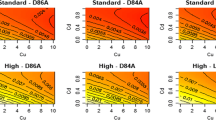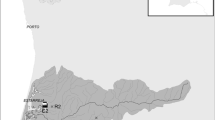Abstract
Population differentiation in Orchesella cincta (L.) (Collembola) populations, from various heavy metal contaminated sites, was studied by comparing cadmium excretion efficiency in first generation (F1) laboratory individuals. Animals from sites with high metal concentrations in the litter and with a long history of contamination showed significantly higher excretion efficiencies than animals from low pollution, or reference sites. Differences found in the F1 laboratory animals suggest evidence for genetic differences between the populations.
Beneficial and detrimental effects of cadmium excretion were studied in relation to body growth and cadmium concentrations. In chronically exposed animals from an unpolluted site, no physiological acclimation was observed. Excretion efficiency was negatively correlated with body concentrations of cadmium. No detrimental effects were found.
Whole-body equilibrium concentrations of cadmium and lead were similar in F1 animals from the reference site and polluted sites. Significant differences in excretion efficiencies imply that the distribution of toxic metals over body compartments differs, tolerant populations having a higher proportion deposited in the gut. Body concentrations of zinc were consistently higher in animals from the polluted site, during both cadmium and zinc exposure. No detrimental effects of increased cadmium excretion on body concentrations of zinc were observed. Population comparisons of cadmium excretion efficiency data and growth reduction in F1 laboratory animals showed that both parameters were inversely related. Cadmium and lead contamination were not the sole factors determining tolerance differentiation.
Similar content being viewed by others
References
Antonovics J, Bradshaw AD and Turner RG (1971) Heavy metal tolerance in plants. Adv Ecol Res 7:1–85
Beeby A (1978) Interaction of lead and calcium uptake by the woodlouse, Porcellio scaber (Isopoda, Porcellionidae). Oecologia (Berlin) 32:255–262
Beeby A, Richmond L (1987) Adaptation by an urban population of the snail Helix aspersa to a diet contaminated with lead. Environ Pollut 46:73–82
— (1988) Calcium metabolism in two populations of the snail Helix aspersa on a high lead diet. Arch Environ Contam Toxicol 17:507–511
— (1989) The shell as a site of lead deposition in Helix aspersa. Arch Environ Contam Toxicol 18:623–628
Bendell-Young LI, Harvey HH, Young JF (1986) Accumulation of cadmium by white suckers (Catostomus commersoni) in relation to fish growth and lake acidification. Can J Fish Aquat Sci 43:806–811
Bengtsson G, Rundgren S (1988) The Gusum case: a brass mill and the distribution of soil Collembola. Can J Zool 66:1518–1526
Bradshaw AD, McNeilly T (1981) Evolution and pollution. Edward Arnold Publishers, London
Calow P (1989) Physiological ecotoxicology; theory, practice and application. In: Løkke H, Tyle H, Bro-Rasmussen F (eds) Proc. 1st European Conference on Ecotoxicology. Copenhagen, Denmark, pp 23–34
Christie NT, Gosslee DG, Bate LC, Jacobson KB (1983) Quantitative aspects of metal ion content and toxicity in Drosophila. Toxicology 26:295–312
Conover WJ (1980) Practical nonparametric statistics. John Wiley & Sons, NY
Cox DR, Hinkley DV (1974) Theoretical statistics. Chapman and Hall, London
Dallai R (1966) L'ultrastruttura del'intestino di Orchesella villosa (Geoffroy) (Insecta, Collembola). Ann Ist Mus Zool Univ Napoli 17:1–18
Donker MH, Bogert CG (1991) Adaptation to cadmium in three populations of the isopod Porcellio scaber. Comp Biochem Physiol 100C:143–146
Endler JA (1986) The newer synthesis? Some conceptual problems in evolutionary biology. In: Dawkins R, Ridley M (eds.) Oxford surveys of evolutionary biology. Oxford University Press, Vol. 3: 224–243
Ernst WHO (1974) Schwermetallvegetation der Erde. Gustav Fischer Verlag, Stuttgart
Falconer DS (1981) Introduction to quantitative genetics, 2nd ed. Longman, London and NY
H»gvar S, Abrahamsen G (1990) Microarthropoda and Enchytraeidae (Oligochaeta) in naturally lead-contaminated soil: a gradient study. Environ Entomol 19:1263–1277
Hopkin SP (1989) Ecophysiology of metals in terrestrial invertebrates. Elsevier Applied Science, London
— (1990) Species-specific differences in the net assimilation of zinc, cadmium, lead, copper and iron by the terrestrial isopods Oniscus asellus and Porcellio scaber. J Appl Ecol 27:460–474
Hopkin SP, Martin MH (1982) The distribution of zinc, cadmium, lead and copper within the woodlouse Oniscus asellus (Crustacea, Isopoda). Oecologia 54:227–232
— (1984) Assimilation of zinc, cadmium, lead and copper centipede Lithobius variegatus (Chilopoda). J Appl Ecol 21:535–546
Humbert W (1978) Cytochemistry and X-ray microprobe analysis of the midgut of Tomocerus minor Lubbock (Insecta, Collembola) with special reference to the physiological significance of the mineral concretions. Cell Tissue Res 187:397–416
Ireland MP (1975) Distribution of lead, zinc and calcium in Dendrobaena rubida (Oligochaeta) living in soil contaminated by base metal mining in Wales. Comp Biochem Physiol 52B:551–555
Ireland MP, Richards KS (1977) The occurrence and localisation of heavy metals and glycogen in the earthworms Lumbricus rubellus and Dendrobaena rubida from a heavy metal site. Histochemistry 51:153–166
Janssen MPM, Joosse ENG, Van Straalen NM (1990) Seasonal variation in concentration of cadmium in litter arthropods from a metal contaminated site. Pedobiologia 34:257–267
Janssen MPM, Bruins A, De Vries TH, Van Straalen NM (1991) Comparison of cadmium kinetics in four soil arthropod species. Arch Environ Cont Toxicol 20:305–312
Joosse ENG (1981) Ecological strategies and population regulation of Collembola in heterogeneous environments. Pedobiologia 21:346–356
Joosse ENG, Van Capelleveen HE, Van Dalen LH, Van Diggelen J (1983) Effects of zinc, iron and manganese on soil arthropods associated with decomposition processes. In: 4th International Conference Heavy Metals in the Environment, Heidelberg, 1983. CEP Consultants, Edinburgh, pp 467–470
Joosse ENG, Verhoef SC (1983) Lead tolerance in Collembola. Pedobiologia 25:11–18
Klerks PL, Levinton JS (1989) Effects of heavy metals in a polluted aquatic ecosystem. In: JR Kelly, KD Kimball (eds) Ecotoxicology: Problems and approaches. Springer-Verlag, NY
Klerks PL, Weis JS (1987) Genetic adaptation to heavy metals in aquatic organisms: A review. Environ Pollut 45:173–205
Maroni G, Wise J, Young JE, Otto E (1987) Metallothionein gene duplications and metal tolerance in natural populations of Drosphila melanogaster. Genetics 117:739–744
Morgan AJ, Gregory ZDE, Winters C (1990) Responses of hepatopancreatic ‘B’ cells of a terrestrial isopod, Oniscus asellus, to metals accumulated from a contaminated habitat: a morphometric analysis. Bull Environ Contam Toxicol 44:363–368
Morgan JE, Morgan AJ (1988) Calcium-lead interactions involving earthworms. Part 2: The effect of accumulated lead on endogenous calcium in Lumbricus rubellus. Environ Pollut 55:41–54
Posthuma L (1990) Genetic differentiation between populations of Orchesella cincta (Collembola) from heavy metal contaminated sites. J Appl Ecol 27:609–622
Russell LK, DeHaven JI, Botts RP (1981) Toxic effects of cadmium on the garden snail (Helix aspersa). Bull Environ Contam Toxicol 26:634–640
Shaw J (1988) Genetic variation of tolerance to copper and zinc within and among populations of the moss, Funaria hygrometrica Hedw. New Phytol 109:211–222
Sober E (1984) The nature of selection. Evolutionary theory in philosophical focus. MIT Press, Cambridge, MA
Sokal RR, Rohlf FJ (1981) Biometry. WH Freeman, San Francisco
Stearns SC (1989) Trade-offs in life-history evolution. Funct Ecol 3:259–268
Taylor MG, Simkiss K (1984) Inorganic deposits in invertebrate tissues. Environ Chem 3:102–138
Tranvik L, Eijsackers H (1989) On the advantage of Folsomia fimetarioides over Isotomiella minor (Collembola) in a metal polluted soil. Oecologia 80:195–200
Van Capelleveen HE (1987) Ecotoxicity of heavy metals for terrestrial isopods. PhD Thesis, Vrije Universiteit, Amsterdam
Van Straalen NM, Burghouts TBA, Doornhof MJ, Groot GM, Janssen MPM, Joosse ENG, Van Meerendonk JH, Theeuwen JPJJ, Verhoef HA, Zoomer HR (1987) Efficiency of lead and cadmium excretion in populations of Orchesella cincta (Collembola) from various contaminated forest soils. J Appl Ecol 24:953–968
Van Straalen NM, Schobben JHM, De Goede RGM (1989) Population consequences of cadmium toxicity in soil microarthropods. Ecotoxicol Environ Saf 17:190–204
Van Straalen NM, Van Meerendonk JH (1987) Biological half-lives of lead in Orchesella cincta (L.) (Collembola). Bull Environ Contam Toxicol 38:213–219
Van Straalen NM, Van Wensem J (1986) Heavy metal content of forest litter arthropods as related to body size and trophic level. Environ Pollut 42:209–221
Wilk MB, Shapiro SS (1968) The joint assessment of normality of several independent samples. Technometrics 10:825–839
Wilson JB (1988) The cost of heavy-metal tolerance: An example. Evolution 42:408–413
Author information
Authors and Affiliations
Rights and permissions
About this article
Cite this article
Posthuma, L., Hogervorst, R.F. & Van Straalen, N.M. Adaptation to soil pollution by cadmium excretion in natural populations of Orchesella cincta (L.) (Collembola). Arch. Environ. Contam. Toxicol. 22, 146–156 (1992). https://doi.org/10.1007/BF00213314
Received:
Revised:
Issue Date:
DOI: https://doi.org/10.1007/BF00213314




